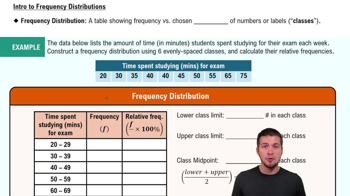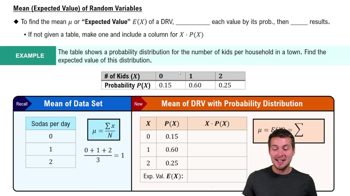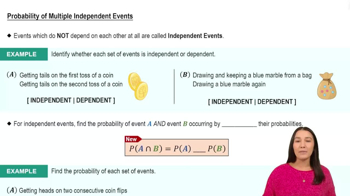For the distribution described in Exercise 1, find the probability of exactly 2 arrivals in one thousandth of a minute.
Table of contents
- 1. Intro to Stats and Collecting Data1h 14m
- 2. Describing Data with Tables and Graphs1h 55m
- 3. Describing Data Numerically2h 5m
- 4. Probability2h 16m
- 5. Binomial Distribution & Discrete Random Variables3h 6m
- 6. Normal Distribution and Continuous Random Variables2h 11m
- 7. Sampling Distributions & Confidence Intervals: Mean3h 23m
- Sampling Distribution of the Sample Mean and Central Limit Theorem19m
- Distribution of Sample Mean - Excel23m
- Introduction to Confidence Intervals15m
- Confidence Intervals for Population Mean1h 18m
- Determining the Minimum Sample Size Required12m
- Finding Probabilities and T Critical Values - Excel28m
- Confidence Intervals for Population Means - Excel25m
- 8. Sampling Distributions & Confidence Intervals: Proportion1h 12m
- 9. Hypothesis Testing for One Sample3h 29m
- 10. Hypothesis Testing for Two Samples4h 50m
- Two Proportions1h 13m
- Two Proportions Hypothesis Test - Excel28m
- Two Means - Unknown, Unequal Variance1h 3m
- Two Means - Unknown Variances Hypothesis Test - Excel12m
- Two Means - Unknown, Equal Variance15m
- Two Means - Unknown, Equal Variances Hypothesis Test - Excel9m
- Two Means - Known Variance12m
- Two Means - Sigma Known Hypothesis Test - Excel21m
- Two Means - Matched Pairs (Dependent Samples)42m
- Matched Pairs Hypothesis Test - Excel12m
- 11. Correlation1h 6m
- 12. Regression1h 50m
- 13. Chi-Square Tests & Goodness of Fit1h 57m
- 14. ANOVA1h 57m
5. Binomial Distribution & Discrete Random Variables
Binomial Distribution
Problem 6b
Textbook Question
In Exercises 5–8, assume that the Poisson distribution applies; assume that the mean number of Atlantic hurricanes in the United States is 5.5 per year, as in Example 1; and proceed to find the indicated probability.
Hurricanes
b. In a 118-year period, how many years are expected to have no hurricanes?
 Verified step by step guidance
Verified step by step guidance1
Step 1: Understand the problem. The Poisson distribution is used to model the number of events (hurricanes) occurring in a fixed interval of time (years). The mean number of hurricanes per year is given as λ = 5.5. We are tasked with finding the expected number of years with no hurricanes over a 118-year period.
Step 2: Recall the formula for the Poisson probability mass function (PMF): P(X = k) = (λ^k * e^(-λ)) / k!, where X is the number of events, λ is the mean number of events, k is the specific number of events (in this case, k = 0 for no hurricanes), and e is the base of the natural logarithm.
Step 3: Calculate the probability of having no hurricanes in a single year using the Poisson PMF. Substitute λ = 5.5 and k = 0 into the formula: P(X = 0) = (5.5^0 * e^(-5.5)) / 0!. Simplify the expression, noting that 0! = 1 and 5.5^0 = 1.
Step 4: Once the probability of no hurricanes in a single year is determined, multiply this probability by the total number of years (118) to find the expected number of years with no hurricanes. Use the formula: Expected years = P(X = 0) * 118.
Step 5: Interpret the result. The final value represents the expected number of years out of 118 that will have no hurricanes, based on the given mean of 5.5 hurricanes per year.
 Verified video answer for a similar problem:
Verified video answer for a similar problem:This video solution was recommended by our tutors as helpful for the problem above
Video duration:
2mPlay a video:
Was this helpful?
Key Concepts
Here are the essential concepts you must grasp in order to answer the question correctly.
Poisson Distribution
The Poisson distribution is a probability distribution that expresses the probability of a given number of events occurring in a fixed interval of time or space, given a known average rate of occurrence. It is particularly useful for modeling rare events, such as natural disasters, where the events are independent of each other.
Recommended video:
Guided course

Intro to Frequency Distributions
Expected Value
The expected value is a key concept in probability that represents the average outcome of a random variable over a large number of trials. In the context of the Poisson distribution, the expected number of occurrences can be calculated by multiplying the average rate (mean) by the number of intervals considered.
Recommended video:
Guided course

Expected Value (Mean) of Random Variables
Probability of No Events
In a Poisson distribution, the probability of observing zero events in a given interval can be calculated using the formula P(X=0) = e^(-λ), where λ is the mean number of events. This concept is crucial for determining how many years in a specified period are expected to have no hurricanes, based on the average rate.
Recommended video:

Probability of Multiple Independent Events

 6:00m
6:00mWatch next
Master The Binomial Experiment with a bite sized video explanation from Patrick
Start learningRelated Videos
Related Practice
Textbook Question
